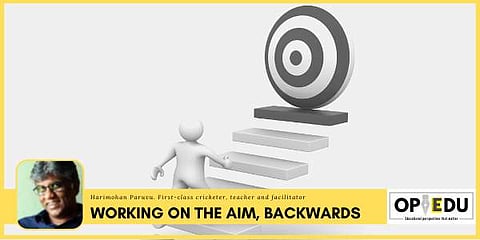

‘Now that we have our roles figured, what’s the next thing to do, bhaiyya?’ asked Rinku.
‘Now you must set team goals,’ said Rakesh. ‘So that every member of your team feels like she has something clear to aim at. Where a role is about expectations, a goal is specific and tangible.’
‘What’s the difference, bhaiyya?’ asked Rahul.
‘A role encompasses the whole gamut and can be subjective. You can choose to expand your role and go beyond what is expected or just do the bare minimum. But with a goal, it's crystal clear what you need to deliver.’
‘Ah, so we can hold our team members responsible for their goals,’ said Rahul.
‘Now, Rahul,’ laughed Rakesh. ‘Goals must be used as a tool to bring out the full potential of your team — not to beat them up.’
‘How, bhaiyya?’ asked Rinku. ‘I really want our team to work at full potential.’
‘There are two ways to do this as a leader,’ said Rakesh. ‘First, get the team to connect to the bigger vision, something larger than themselves, larger than today’s deliverables. Secondly, set team goals that stretch the team to achieve its potential. It is up to you as the leader to find the right balance where each member delivers to her potential — not break their spirit. Once you do that, you have a team that’s a winner. You’ve done your job as a leader.’
‘Wow!’ said Rahul. ‘How, bhaiyya?’
‘It’s easy to set such goals when you begin with the end in mind and work backwards,’ said Rakesh. ‘You have a vision for your group for the year, right?’
‘Yes,’ said Rinku. ‘To win this year’s championship.’
‘Take a longer-term vision, like, say ten years,’ said Rakesh. ‘Long enough for your group to achieve full potential. So tell me, what would your group achieve at full potential in 20 years — in terms of activities, achievements, numbers, medals, brands, news and so on?’
‘Wow,’ said Rahul. ‘That’s really long term. But we won’t be here after next year. Why such a long term vision?’
‘Because you have to set the ball rolling for years to come, whether you are there or not,’ said Rakesh smiling. ‘Whether it’s a company or a country or your group, that’s what you as the leader must do.’
‘I’d like our group to be the champion group, espousing our values and taking the lead over the rest in ten years,’ said Rinku. ‘Would that be a good goal, bhaiyya?’
‘Good to start with,’ said Rakesh. ‘But use the SMART framework — Specific, Measureable, Achievable, Relevant and Time-bound to set your goal.’
‘Okay,’ said Rahul. ‘Our group should be the winner every year and lead in all categories sports, literature, cultural and social activities.’
‘How about also producing ten international champions in sports, literature and cultural areas in ten years?’ asked Rinku. ‘And taking the lead in making our college the best in extra-curricular activities in colleges across India?’
‘Why not across the world?’ asked Rakesh. ‘It’s possible in ten years right?’
‘Why not?’ said Rahul. ‘It would be great to have people across the world seeking out our college to study in.’
‘Okay, you have a great vision for ten years,’ said Rakesh. ‘Now set five-year goals working backwards from your ten-year goals.’
‘Our group has contributed five international champions and is contributing to our college as well by winning all national championships,’ said Rinku. ‘We have established a national presence for our college.’
‘Great,’ said Rakesh. ‘Now, set goals for two years.’
‘In two years, we can look at producing two international champions from the college, win all local champions and become number one in South India,’ said Rinku.
‘And in two years, we can aim to be local champions and make our festival the best in South India,’ said Rahul. ‘Wow, sure feels good to even imagine that.’
‘Super,’ said Rakesh. ‘Now, with this background, set your goals for this year for your team.’
‘Hmm,’ said Rinku. ‘Win the college championship first and gain maximum points in all areas. Then work on laying the foundation for what we want to achieve in the coming ten years. Identify leaders for the future and attune them to our vision, pick the right people, identify right mentors and coaches, establish systems, make clubs plus enter and initiate competitions.’
‘Oof,’ said Rahul. ‘These thoughts would never have come if we had not worked backwards from the longer-term vision. Instead of setting random goals, we’re keeping our larger goals in mind.’
‘Yes,’ said Rakesh. ‘It will help everyone to connect to the long term vision and keep you one and all motivated. When we begin with the end in mind, we lay the foundation correctly.’
‘Wonderful, bhaiyya,’ said Rinku. ‘We will refine this idea further and set our team goals accordingly. Then we will set our individual goals within the team.’
Pro Tip: To set team goals right, drill back from a long term vision and you’ll connect to a goal that stretches the team and drives every member of the team towards achieving its potential.
